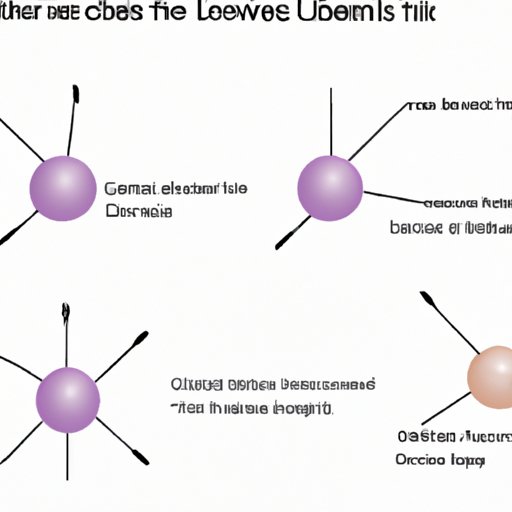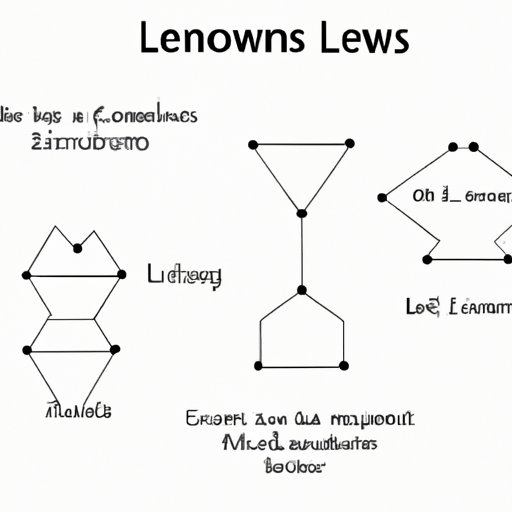
How to Draw Lewis Structures: Understanding the Basics
Chemistry can be a daunting subject for many students, especially when it comes to complex concepts such as Lewis structures. Drawing Lewis structures is an essential skill that every chemistry student needs to master. A Lewis structure is a diagram that shows the covalent bonds between atoms and the distribution of electrons around the atoms involved.
Understanding how to draw Lewis structures plays a crucial role in predicting molecular geometry, chemical reactions, and molecular properties. This article will provide a comprehensive guide on how to draw Lewis structures. From basic to advanced techniques, this article will help you master Lewis structures in no time.
7 Easy Steps to Master Lewis Structures for Chemistry Students
Here are seven easy steps to help you draw Lewis structures with ease:
- Identify the central atom.
- Count the total number of valence electrons.
- Use a single bond to connect the central atom to the other atoms.
- Distribute the remaining valence electrons around the atoms to satisfy the octet rule.
- Check the valence electrons. If all atoms have eight electrons, the Lewis structure is complete.
- If the central atom has less than eight electrons, form double or triple bonds until the octet rule is satisfied.
- Check for resonance structures, if necessary.
Following these seven steps will lead you to the correct Lewis structure for a given molecule or compound. Let’s explore each step in detail.
Step 1: Identify the central atom
The central atom is usually the atom with the lowest electronegativity or the least number of valence electrons. The other atoms are connected to it by covalent bonds.
Step 2: Count the total number of valence electrons
Valence electrons are the electrons in the outermost shell of an atom. To determine the number of valence electrons for each atom, follow the periodic table. For example, carbon has four valence electrons while oxygen has six.
Once you have identified the central atom and counted the number of valence electrons, add up the total number of valence electrons for all the atoms involved in the molecule or compound.
Step 3: Use a single bond to connect the central atom to the other atoms
Use a single bond to connect the central atom to the other atoms. A single bond represents two electrons in the Lewis structure. For example, in CO₂, carbon is the central atom, and it is connected to two oxygen atoms by single bonds.
Step 4: Distribute the remaining valence electrons around the atoms to satisfy the octet rule
The octet rule states that the outermost shell of an atom should have eight electrons. Distribute the remaining valence electrons around the atoms to satisfy the octet rule except for hydrogen which needs only two valence electrons.
Remember to place lone pairs of electrons on the atoms connected to the central atom before placing them on the central atom. Additionally, when determining which atom receives the lone pair electron, the most electronegative atoms get the first priority.
Step 5: Check the valence electrons
Once all the valence electrons have been distributed, count the number of valence electrons around each atom. Every atom, except hydrogen, should have an octet (eight valence electrons).
Step 6: If the central atom has less than eight electrons, form double or triple bonds until the octet rule is satisfied
If the central atom has less than eight valence electrons, use multiple bonds. Double bonds contain four electrons while triple bonds contain six electrons. These bonds can be arranged around the central atom to satisfy the octet rule.
Step 7: Check for resonance structures, if necessary
In some cases, a molecule or compound may have more than one possible Lewis structure. When this happens, multiple structures are drawn, and they are called resonance structures. These structures only differ in the placement of electrons and not the arrangement of atoms.
How to Draw Lewis Structures: A Beginner’s Guide
Now that you are familiar with the seven easy steps to draw Lewis structures, let’s delve deeper into the basic principles that govern Lewis structures.
Basic Principles of Lewis Structures
Before you start drawing Lewis structures, it is important to understand the basic principles that govern how these structures are drawn. Here are some principles:
- Atoms will form enough bonds to have eight valence electrons, except for hydrogen and helium, which only need two valence electrons.
- The central atom is usually the least electronegative element in the molecule.
- Lone pairs count towards the total number of valence electrons.
Detailed instructions for drawing simple Lewis structures
Let’s use water (H₂O) as an example of how to draw a simple Lewis structure.
The first step is to identify the central atom. In H₂O, oxygen (O) is the central atom since it has the highest electronegativity.
The second step is to count the valence electrons. Hydrogen has one valence electron, and oxygen has six valence electrons, giving a total of eight valence electrons.
The third step is to draw a single bond between the central atom (oxygen) and the surrounding atoms (hydrogen). In the case of H₂O, there are two hydrogen atoms that share one pair of electrons with the central atom.
The fourth step is to distribute the remaining valence electrons around the atoms. Since we have already used two electrons to form single bonds, we have six electrons left. We have to use these electrons to satisfy the octet rule. Oxygen has already satisfied the octet rule with six electrons. Since each hydrogen atom requires two valence electrons, each of the remaining four electrons is placed on hydrogen atoms, resulting in two lone pairs of electrons around oxygen.
When all valence electrons have been distributed, check to see if each atom has an octet of electrons. In the case of water, oxygen has eight electrons, while each hydrogen atom has only two valence electrons. In this case, the central atom has fulfilled the octet rule, while the two hydrogen atoms still have room for their missing electrons. We account for this by forming a single bond between the two hydrogen atoms, resulting in a finished structure like this:
Tips for Identifying the Central Atom and Counting Valence Electrons
Identifying the central atom is essential in drawing Lewis structures. Here are tips for identifying the central atom:
- The central atom is usually the atom with the lowest electronegativity or the least number of valence electrons.
- The central atom can never be a hydrogen atom.
- The central atom must be able to form a covalent bond with at least one other atom.
Counting valence electrons is also crucial. Here are some tips to help you count:
- Valence electrons are the outermost electrons of an atom.
- The number of valence electrons for each element is equal to the number of electrons in the outer shell.
- The valence electrons of the central atom can be found by adding up the valence electrons of all the surrounding atoms and subtracting them from the total number of valence electrons.
Expert Tips for Drawing Lewis Structures with Precision
As you become more confident with drawing Lewis structures, you may find yourself dealing with more complex structures. Let’s take a look at some expert tips that can help you draw complex Lewis structures with precision.
Strategies for Drawing More Complex Lewis Structures
When it comes to more complex molecules, you need to use different strategies for drawing Lewis structures. Here are some strategies to help you with your drawings:
- Use symmetry to simplify the structure.
- Identify all resonance structures.
- If an atom has more than one charge, use brackets to indicate the charge.
- When dealing with ions, add or subtract electrons accordingly.
- Draw Lewis structures for each individual atom.
Tips for Identifying Resonance Structures
Resonance structures are Lewis structures that represent a hybrid of two or more possible Lewis structures. Identifying them is essential in understanding the structure of complex molecules. Here are some tips to help you identify resonance structures:
- If the molecule has the same structure but different placement of electrons, it is a resonance structure.
- If one atom has a double bond to two different atoms, that molecule likely has resonance structures.
Formal Charges and How To Use Them
Formal charges are used to determine the most appropriate placement of electrons in a Lewis structure. Formal charges are calculated by determining the difference between the number of valence electrons of an atom in its free state and the number of electrons it has in a covalent bond. Here are some things to remember when using formal charges:
- The formal charges of all atoms should add up to the overall charge of the molecule.
- The most stable Lewis structure has the smallest formal charges possible or no formal charges at all.
Lewis Structure Illustration: An In-Depth Tutorial
Here, we’ll be going over a more detailed example of a Lewis Structure with ammonia (NH₃).
Step 1 is to identify the central atom. In NH₃, nitrogen is the central atom.
Step 2 requires us to count the total number of valence electrons. Nitrogen has five valence electrons while hydrogen has one, giving a total of eight electrons.
Step 3 involves using one line to connect the central atom to the other atoms. In NH₃, nitrogen is connected to three hydrogen atoms by single bonds.
Step 4 requires the distribution of the remaining valence electrons. Following the octet rule, nitrogen needs to have eight electrons in its outer shell while each hydrogen atom needs two.
The final step is to determine formal charges. In NH₃, the nitrogen atom receives a lone pair of electrons. It carries a negative charge, while each hydrogen atom carries a positive charge. The total charge of the molecule is zero, so the formal charges of the atoms add up to zero.
Teaching Lewis Structures: Strategies for Educators
Teaching Lewis structures can be challenging as it involves complex concepts that may be hard for students to grasp. Here are some strategies that educators can use to effectively teach Lewis structures to their students:
- Break down the process into simple steps.
- Ensure that students understand the basic principles of valence electrons and covalent bonds.
- Use visual aids such as diagrams and videos to aid understanding.
- Provide students with plenty of practice problems to help them develop their skills.
Shortcut Techniques for Drawing Lewis Structures Quickly
For most commonly occurring molecules and compounds, certain shortcuts can be used to help draw Lewis structures more quickly. Some of these techniques include:
- Recognizing the number of valence electrons in specific groups of elements, such as halogens, alkali metals, and alkaline earth metals.
- Identifying common molecules such as CO₂, H₂O, and NH₃ that have standard Lewis structures.

Common Mistakes When Drawing Lewis Structures and How to Avoid Them
Drawing Lewis structures can involve some complex calculations and concepts that can be hard for students to grasp. Here are some common mistakes when drawing Lewis structures and how to avoid them:
- Mismatching valence electrons with atoms. Ensure that valence electrons are assigned to the correct atom.
- Improper placement of electrons. Lone electron pairs should be placed on the central atom before surrounding atoms.
- Forgetting formal charges. Formal charges are required to determine the most stable Lewis structure.
Conclusion
Understanding Lewis structures is a fundamental part of chemistry. Drawing Lewis structures helps predict the geometry of molecules and their chemical properties. In this article, we have covered the basics of Lewis structures, from simple to more complex structures, providing step-by-step instructions to follow. The article also covers expert tips, teaching and shortcut techniques, common mistakes, and how to avoid them. Practice drawing Lewis structures to master this essential chemistry skill.





